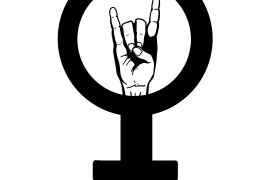When hearing the word abolition, people may first think of slavery abolitionists such as Frederick Douglass, Sojourner Truth, Harriet Tubman, John Brown, or the countless others who fought for the abolition of slavery. While the term itself is defined broadly as a movement to end something such as slavery, the conversation of police abolition recently surfaced into the mainstream discourse after Minneapolis police officer Derek Chauvin murdered George Floyd on May 25, 2020, sparking nationwide protests that called for the defunding of police.
As an initial step in the right direction towards abolition, defunding the police is only part of the broader movement to abolish the prison-industrial complex. In her book, We Do This ‘Til We Free Us, Mariame Kaba writes that “prison-industrial complex abolition is a political vision, a structural analysis of oppression, and a practical organizing strategy,” and that “prison-industrial complex abolition is a vision of a restructured society in a world where we have everything we need: food, shelter, education, health, art, beauty, clean water, and more things that are foundational to our personal and community safety.”
A central component of the abolition movement is that policing, and the prison-industrial complex at large, not only fail to keep us safe, they are active tools of oppression used by the state that cause us harm. For those who marched after the police murdered George Floyd in 2020, there was a sense of hope that police funding may finally get slashed. But like any radical movement that gains momentum in the mainstream, it was ultimately co-opted and pacified, then used as a tool to control the narrative surrounding policing.
The support that many Democrats and progressives in government had for the calls to defund the police predictably crumbled when pressed by then President Trump and others who pushed the narrative of rising crime. This co-opting of a movement before inevitably distancing themselves from the same movement is par for the course for the Democratic Party that relies more on symbolic gestures of allyship rather than tangible actions that would create meaningful progress.
While many in the Republican Party, mainstream media, and the law-enforcement-friendly Democratic Party itself have blamed rising crime on the widespread defunding of police budgets, facts state otherwise. ABC examined police budgets in 109 cities and counties across the nation and found that 83 percent spent at least two percent more on police in 2022 compared to 2019, and 49 had actually increased their budgets by more than ten percent. The reality is that only eight agencies of the 109 in their study had cut police budgets by more than two percent. This data reflects that not only were budget cuts few and far between, but the public outcry over widespread budget cuts is an example of how effective “copaganda” sways public opinion.
The Portland chapter of the national grassroots abolitionist organization Critical Resistance successfully pushed the City of Portland to reduce the 2020–2021 Portland Police Bureau (PPB) budget by $15M with their Care Not Cops campaign. Additionally, the final budget included the disbanding of PPB’s Gun Violence Reduction Team and a reallocation of funding towards other community programs such as the $4.8M for the Portland Street Response.
Many of the cities that had reallocated funding from police budgets to community programs have already had those decisions reversed, including here in Portland. The reversals here are shown through the approved PPB budget for 2022–2023, which totals $12M more than their $249M budget in 2019–2020. That budget will also create the Focused Intervention Team (FIT), which has a similar mission to that of the disbanded GVRT.
These narratives state that crime is rising at a rapid rate and that the only thing that prevents crime is more policing, leading to both political parties competing for the title of the “law and order” party. What is lost in the shuffle is that while politicians and mainstream media push the rising crime narrative, the data being used is murky at best and manipulated at worst in an effort to push false narratives.
When it comes to copaganda, Civil Rights lawyer Alec Karakatsanis states that its three functions are to narrow our understanding of safety, to manufacture crime surges as a crisis and to manipulate our perceptions of what solutions should be pursued to keep us safe. This copaganda is pushed by police, politicians, and the media—over 50 percent of all broadcast TV shows in 2020 were cop shows.
One of these perceptions is that more police will lead to more safety, yet with over $115B spent on policing per year in this country and over $81B annually on mass incarceration, these rising crime narratives should be nonexistent. Spending more on policing and the entire prison-industrial complex as a solution to crime seems quite wasteful, considering we already spend an enormous amount of money on policing and incarceration.
Prisons and punishment in general are also insufficient in providing safety or even rehabilitation, and are themselves the cause of many forms of violence. Nearly two million people are locked up in prisons in the U.S., including half a million who are held in jails awaiting trial despite not being convicted of a crime, primarily due to an inability to pay the amount required for bail. Sometimes they are held for months or even years before seeing a trial, unless they die awaiting trial while presumed innocent. With the median bail amount of ten thousand dollars, this is nothing other than punishment for the crime of being poor.
When it comes to violent crime, some will say that we need more police and harsher punishment, yet according to the Vera Institute of Justice, less than five percent of the ten million arrests made each year are for violent crimes. Police often arrive well after the harm has been committed and only solve less than a quarter of those cases. While convoluted to begin with, crime stats also fail to include the crimes that are much more violent and harmful to a greater number of people.
What gets defined as a crime—including violent crimes—gets further complicated by the word itself. The word crime itself is a social construct that describes the current legal status of a behavior or those who participate in it. The description itself is fluid as states can criminalize certain behaviors while ignoring others. Evictions, wage theft, camp sweeps of those experiencing houselessness, structural and environmental violence and all the violence caused by policing are left out of crime statistics—or are not even defined as criminal—all while causing an enormous amount of violence on a much larger scale.
While local news organizations in Portland and throughout the country have been pushing the surge in retail theft narrative, both the police and these same news organizations fail to address the estimated $50B in wage theft that is taken from mostly low-wage workers annually, an amount that is five times higher than the cost in shoplifting. Additionally, the estimated cost of tax fraud committed by the wealthy and corporations is now at trillion dollars a year. Crime and criminalization are used to punish the poor, while police protect the elite and wealthy businesses that cause a disproportionate amount of harm and violence.
So what does an abolitionist future look like? What steps are needed to move in a direction that sees the end of the prison industrial complex?
When thinking of solutions outside of funding policing and incarceration, money would be wiser spent by being invested into communities. Affordable housing, universal access to healthcare, investments in education, youth programs, community-based intervention teams and investing in the community would all be more viable solutions than the money spent on policing. Transformative and restorative justice will help us shift from punishment to accountability, as the punishment that is implemented by our carceral system not only fails to keep us safe, but also causes great harm.
The Black Panthers Ten Point Program represents an example of a historical movement with a community driven focus, where members of the party were to actively live by the stated guidelines in their daily lives to center the Black Community against the numerous injustices that still exist nearly 60 years later. Since the Black Panthers created the Ten Point Program in 1966, many abolitionists have advanced the ball in new ways that shifts away from the use of a court system while building off the foundation of the Ten Point Program and its envisioning of a future where abolition has come into fruition.
In No More Police, Mariame Kaba writes that “our ultimate goal must be abolition of all forms of surveillance, policing, and punishment and the systems that require them if we are to achieve true public safety.” Abolishing police unions, disarming police, divesting from police budgets and reinvesting in the community, ending cash bail and creating community-based intervention teams—like the Portland Street Response and Eugene’s CAHOOTS—are just some of the many different steps that can be taken when moving towards a future without prisons.
To believe we can fix the problems of the prison-industrial complex with reforms such as body cameras, better training, or police accountability, is to ignore the fact that not only do police already receive all of these resources, they continue to cause great harm to the communities they control. Reformist policies that give police more money, power or technology should never be pursued, as they not only legitimize the carceral system and the dominant narratives surrounding policing, they simply don’t work.
When thinking of reformist policies, I am reminded of the title of an essay by Audre Lorde, titled “The Master’s Tools Will Never Dismantle the Master’s House.” Although those who push for reformist policies are likely not doing so with the goal of dismantling the prison-industrial complex, to believe that these policies will fix policing is a belief based in naivety.
To try and cover prison abolition in such a short article would be impossible—and in some ways disrespectful—as many abolitionists have spent years fighting for a future without police and prisons and have an enormous body of work to show for it. BIPOC abolitionists such as Mariame Kaba, Angela Davis, Andrea Ritchie, Ruth Wilson Gilomore, Kelly Hayes and Derecka Purnell are just some of the many activists who possess an extensive amount of knowledge and experience that should be looked to for inspiration as we work towards a future without prisons and police.
The road towards abolition is one that requires ongoing struggle, experimentation and organizing. Andrea Ritchie and Mariame Kaba, co-authors of No More Police, write “there is no fixed roadmap to abolition; instead we must spend time imagining, strategizing, and practicing other futures. There is, however, a clear case for why policing can play no role in that future.” While the goal of abolition seems daunting, it is a collective struggle that we must envision and work for on a daily basis as we dismantle the institutions that cause harm while building a better future today.





